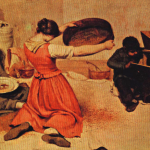Jallikattu Ban: Cruelty in the name of Culture Hindi
What is JalliKattu?
- The term has originated from two words: ‘Jalli’ and ‘Kattu’.
- These terms refer to gold or silver coins tied to the bulls’ horn.
- The sport has three variants:
- A person tries to hang on a bull for a specified time or distance.
- A bull is released and participants try to control the animal.
- The bull is tied to a 50-feet rope for a team to subdue it within a specified time.
A timeline of events
- In 2006, the Madras HC banned Jallikattu.
- In March 2007, the Tamil Nadu government got the ban overturned which, after four months, was reimposed by the supreme court.
- In January 2008, the apex court allowed the sport as part of pongal celebrations.
- From 2009 till 2011, after the state government passed laws to regulate the sport, it was permitted under supervision.
- The Supreme Court of India had banned Jallikattu in 2014. But the central government in January 2016 issued a notification permitting the exhibition and use of bulls as performing animals for Jallikattu and bullock-cart races .
- The Supreme Court of India has pulled up the central government for its January 7 notification permitting Jallikattu despite the court’s judgement banning the bull taming sport. The court had stayed the government notification on January 12. Let us have a look at both sides of the story.
In Favour of Jallikattu
- When humans can race, why can’t bulls?
- Even Spain has permitted bull fighting sport in the name of cultural heritage.
- Tales from Mahabharatha have been put forward to convince the supreme court of the sport’s ability to maintain biodiversity.
- It encourages breeding of indigenous bulls.
- It is an ancient tradition practiced from time immemorial and not just a sport for entertainment.
- The ban can affect the fundamental right to life and livelihood of millions in southern India.
- There are enough safeguards for the bulls.
- Bulls will be slaughtered if banned.
- The sport is a symbol of a close relationship between agriculturalists’ and their cattle.
- Humans participate in the race without any weapons while the bull has sharp horns which can kill a person immediately. This means bulls are more capable of causing injury to humans and not the other way round.
In Favour of the Ban on Jallikattu
- It is a cruel sport and cruelty to animals is prohibited by the law.
- Bulls cannot be made to suffer just for the sake of human entertainment.
- Humans run in races with their free will but bulls are forced to participate and are made to suffer unnecessary pain and suffering.
- The bull has been classified as a draught animal not meant for running but sedate walking.
- So what if it is an age old tradition, even child marriage was an ancient tradition until it was declared a crime.
- Even humans are killed and many injured during bull fight.
- Article 51A in the constitution of India deals with fundamental duties of the citizens. The 7th fundamental duty obliges us to have compassion for living creatures.
- The SC had also expanded the scope of Article 21 (Right to Life) by including the prohibition of any disturbance to the environment, including animals, considered essential for human life.











